高中英语人教版必修5Unit3LifeinthefutureReading教案(系列五)
- 格式:doc
- 大小:290.00 KB
- 文档页数:5
![人教英语必修五Unit3Lifeinthefuture-Reading[课件]](https://uimg.taocdn.com/8a40e82deff9aef8941e06a7.webp)
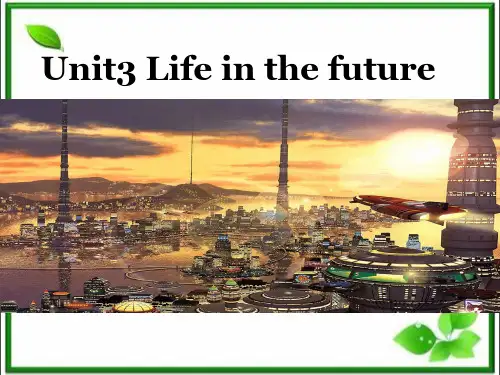
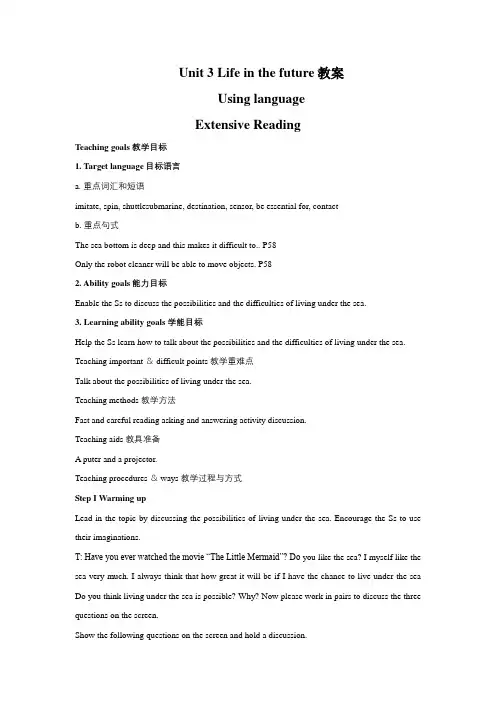
Unit 3 Life in the future教案Using languageExtensive ReadingTeaching goals 教学目标1. Target language目标语言a. 重点词汇和短语imitate, spin, shuttlesubmarine, destination, sensor, be essential for, contactb. 重点句式The sea bottom is deep and this makes it difficult to.. P58Only the robot cleaner will be able to move objects. P582. Ability goals能力目标Enable the Ss to discuss the possibilities and the difficulties of living under the sea.3. Learning ability goals 学能目标Help the Ss learn how to talk about the possibilities and the difficulties of living under the sea. Teaching important & difficult points 教学重难点Talk about the possibilities of living under the sea.Teaching methods 教学方法Fast and careful reading asking and answering activity discussion.Teaching aids 教具准备A puter and a projector.Teaching procedures & ways 教学过程与方式Step I Warming upLead in the topic by discussing the possibilities of living under the sea. Encourage the Ss to use their imaginations.T: Have you ever watched the movie “The Little Mermaid”? Do you like the sea? I myself like the sea very much. I always think that how great it will be if I have the chance to live under the sea Do you think living under the sea is possible? Why? Now please work in pairs to discuss the three questions on the screen.Show the following questions on the screen and hold a discussion.1. Do you think living under the sea is possible?2. Where are you going to live under the sea?3. In the undersea cities, what equipments do you think are necessary?Ten minutes later, ask some Ss to answer the questions.T: Have you finished? Who would like to tell us your opinion? V olunteer?S: I think it’s possible. Maybe in the future scientists will invent some kind of equipment that makes it possible for human being to live under the sea.T: If it is possible, where are you going to live under the sea? There is all water and fishes around you.S: Maybe in a special equipment which will provide us muchneeded oxygen and can float in the water. In that case we can travel in the sea to enjoy the wonderful view of the sea.T: Good. If you are going to live under the sea, what kind of equipment do you think is necessary for your living?S: Oxygen provision and cleaning machine may be necessary.Step Ⅱ ReadingDeal with the passage on page 58.T: OK. From what you said, I know all of you are looking forward to living under the sea. Now a pany just provides the very service Please turn to page 58 and read the passage RISING TO A CHALLENGE. Let’s see what the life will be like in this undersea city. When you finish reading, plete the sentences on the screen.Give the Ss 3 minutes to go through the whole passage.1. The undersea city is so fortable that it is described as ___________ .2. The undersea city has the following advantages:a. _____________b. _____________c. _____________d. _____________T: Can you find out some suitable sentences or words to fill in the blanks? What are the advantages of living under the sea?S: The undersea city is so fortable that it is described as “a silk adventure”.S: The undersea city has the following advantages:a.easy contact with the land surfaceb.b. more personal spacec. plete personal securityd. no housework worries.T: That’s great. You all have got the general idea of the passage. Now let’s look into some detailed aspects of the undersea city. First let’s look at its contact with the land surface. Who would like to tell me at the very beginning, what kind of problem were they facing? And how was the problem solved?S: The sea bottom is so deep tha t it’s hard to contact with the land surface. But later they invented the oneperson or family shuttlesubmarines which will always be ready to take people to the surface.T: So in that case people who live under the sea can easily contact with the land surface. Then paring with living on land, what advantage do you think can attract people to live under the sea? S: We can get twice as much personal space as in flats on land.T: Good Then what kind of special equipment will be provided so as to realize all the advantages? Please read the text again and finish the following chart. You can work with your partners.Show the chart on the screen and give the Ss 3 minutes to go through the whole text again to scan for the answer. A few minutes later, check the answers.T: This undersea city is amazing. But I think designing such kind of undersea city is quite difficult Do you want to meet its designer? Now the designer of the city William Lee is being interview. Let’s listen to his interview and find out which two problems he came across and how he solved them. Then please finish the exercises on page 59....Step Ⅲ Followup ActivitySet a scene for the Ss: The pany is going to held a press conference and exhibition. Encourage the Ss to design a poster which will draw visitors’ attention and provide some useful information.T: We know that all new products have to be promoted so that it can be wellknown among people. Now a press conference and exhibition is going to be held to make the undersea city known to people. If you work in the pany, can you design a special poster to draw visitors’ attention so that they will e to the press conference? Use your imagination and you can discuss with your group members.A Sample poster:e to this meetingSee the value of OUR undersea houses.Saturation City has:● easy contact with the land surface● more personal space● plete personal security● no housework worriesCost: 20 dollarsDate: May 18thTime: 8:00 amPlace: The Science Exhibition BuildingStep Ⅳ HomeworkT: After class, please listen to the tape repeatedly until you can retell it yourselves and payattention to pronunciation.。
![人教版高中英语必修五Unit3Lifeinthefuture-Reading[新课件]](https://uimg.taocdn.com/78ecad10482fb4daa58d4bec.webp)
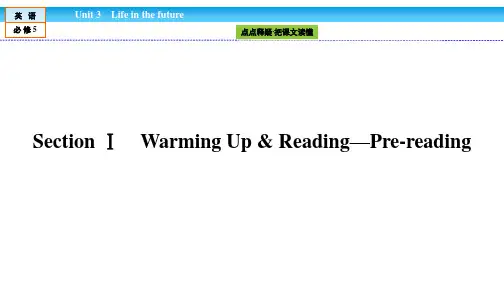
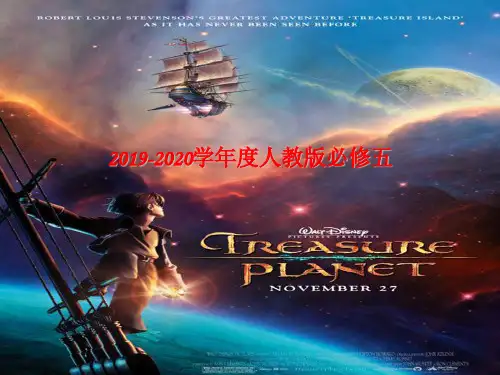
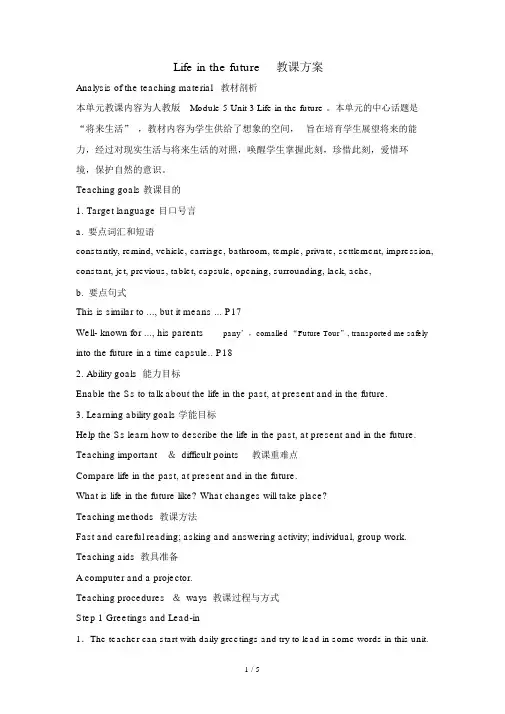
Life in the future教课方案Analysis of the teaching material教材剖析本单元教课内容为人教版Module 5 Unit 3 Life in the future 。
本单元的中心话题是“将来生活” ,教材内容为学生供给了想象的空间,旨在培育学生展望将来的能力,经过对现实生活与将来生活的对照,唤醒学生掌握此刻,珍惜此刻,爱惜环境,保护自然的意识。
Teaching goals 教课目的1. Target language 目口号言a.要点词汇和短语constantly, remind, vehicle, carriage, bathroom, temple, private, settlement, impression, constant, jet, previous, tablet, capsule, opening, surrounding, lack, ache,b.要点句式This is similar to ..., but it means ... P17Well- known for ..., his parents pany’,comalled “Future Tour”, transported me safely into the future in a time capsule.. P182. Ability goals 能力目标Enable the Ss to talk about the life in the past, at present and in the future.3. Learning ability goals 学能目标Help the Ss learn how to describe the life in the past, at present and in the future. Teaching important&difficult points教课重难点Compare life in the past, at present and in the future.What is life in the future like? What changes will take place?Teaching methods 教课方法Fast and careful reading; asking and answering activity; individual, group work. Teaching aids 教具准备A computer and a projector.Teaching procedures&ways教课过程与方式Step 1 Greetings and Lead-in1.The teacher can start with daily greetings and try to lead in some words in this unit.Q1: Where do you come from? Do you live in the downtown or in the countryside? 2.Q2: No matter where you live, I am wondering how do you usually go to school? 3.Now let’s take a look at the screen to learn about the development of all the means of transportation.4.Q3: What will the future means of transportation be like? (Time travel)【设计说明】由平时问候开启话题,经过发问学生展望将来,引出跨时空旅游,进而进入阅读文章的办理与学习。
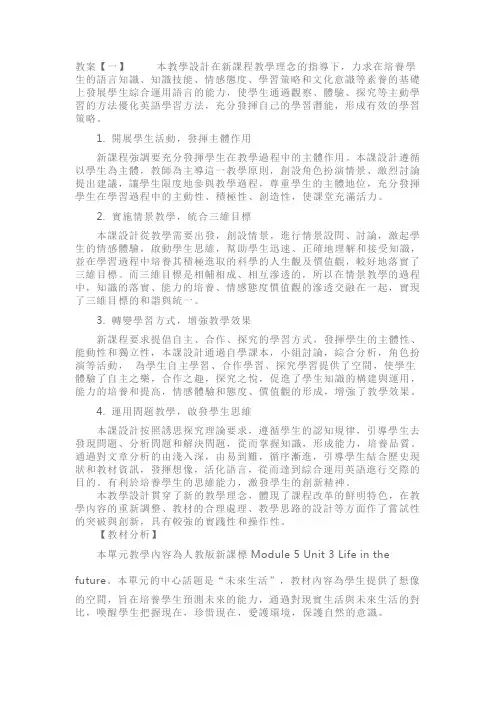
教案【一】本教學設計在新課程教學理念的指導下,力求在培養學生的語言知識、知識技能、情感態度、學習策略和文化意識等素養的基礎上發展學生綜合運用語言的能力,使學生通過觀察、體驗、探究等主動學習的方法優化英語學習方法,充分發揮自己的學習潛能,形成有效的學習策略。
1. 開展學生活動,發揮主體作用新課程強調要充分發揮學生在教學過程中的主體作用。
本課設計遵循以學生為主體,教師為主導這一教學原則,創設角色扮演情景、激烈討論提出建議,讓學生限度地參與教學過程,尊重學生的主體地位,充分發揮學生在學習過程中的主動性、積極性、創造性,使課堂充滿活力。
2. 實施情景教學,統合三維目標本課設計從教學需要出發,創設情景,進行情景設問、討論,激起學生的情感體驗,啟動學生思維,幫助學生迅速、正確地理解和接受知識,並在學習過程中培養其積極進取的科學的人生觀及價值觀,較好地落實了三維目標。
而三維目標是相輔相成、相互滲透的,所以在情景教學的過程中,知識的落實、能力的培養、情感態度價值觀的滲透交融在一起,實現了三維目標的和諧與統一。
3. 轉變學習方式,增強教學效果新課程要求提倡自主、合作、探究的學習方式,發揮學生的主體性、能動性和獨立性,本課設計通過自學課本,小組討論,綜合分析,角色扮演等活動,為學生自主學習、合作學習、探究學習提供了空間,使學生體驗了自主之樂,合作之趣,探究之悅,促進了學生知識的構建與運用,能力的培養和提高,情感體驗和態度、價值觀的形成,增強了教學效果。
4. 運用問題教學,啟發學生思維本課設計按照誘思探究理論要求,遵循學生的認知規律,引導學生去發現問題、分析問題和解決問題,從而掌握知識,形成能力,培養品質。
通過對文章分析的由淺入深,由易到難,循序漸進,引導學生結合歷史現狀和教材資訊,發揮想像,活化語言,從而達到綜合運用英語進行交際的目的。
有利於培養學生的思維能力,激發學生的創新精神。
本教學設計貫穿了新的教學理念,體現了課程改革的鮮明特色,在教學內容的重新調整、教材的合理處理、教學思路的設計等方面作了嘗試性的突破與創新,具有較強的實踐性和操作性。
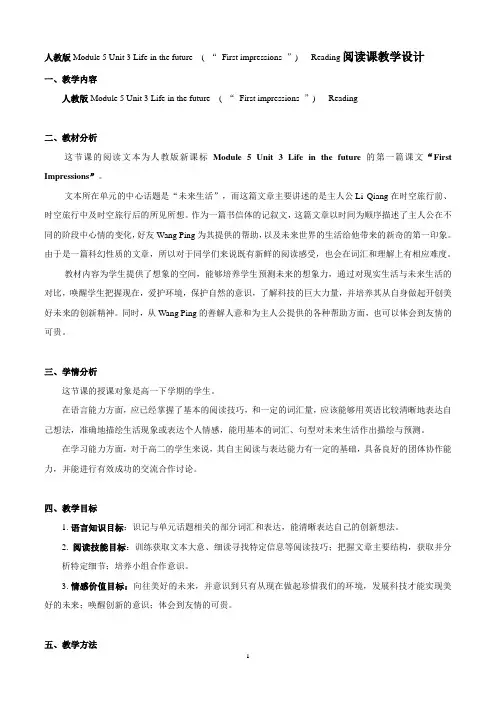
人教版Module 5 Unit 3 Life in the future ( “First impressions ”) Reading阅读课教学设计一、教学内容人教版Module 5 Unit 3 Life in the future ( “First impressions ”) Reading二、教材分析这节课的阅读文本为人教版新课标Module 5 Unit 3 Life in the future的第一篇课文“First Impressions”。
文本所在单元的中心话题是“未来生活”,而这篇文章主要讲述的是主人公Li Qiang在时空旅行前、时空旅行中及时空旅行后的所见所想。
作为一篇书信体的记叙文,这篇文章以时间为顺序描述了主人公在不同的阶段中心情的变化,好友Wang Ping为其提供的帮助,以及未来世界的生活给他带来的新奇的第一印象。
由于是一篇科幻性质的文章,所以对于同学们来说既有新鲜的阅读感受,也会在词汇和理解上有相应难度。
教材内容为学生提供了想象的空间,能够培养学生预测未来的想象力,通过对现实生活与未来生活的对比,唤醒学生把握现在,爱护环境,保护自然的意识,了解科技的巨大力量,并培养其从自身做起开创美好未来的创新精神。
同时,从Wang Ping的善解人意和为主人公提供的各种帮助方面,也可以体会到友情的可贵。
三、学情分析这节课的授课对象是高一下学期的学生。
在语言能力方面,应已经掌握了基本的阅读技巧,和一定的词汇量,应该能够用英语比较清晰地表达自己想法,准确地描绘生活现象或表达个人情感,能用基本的词汇、句型对未来生活作出描绘与预测。
在学习能力方面,对于高二的学生来说,其自主阅读与表达能力有一定的基础,具备良好的团体协作能力,并能进行有效成功的交流合作讨论。
四、教学目标1.语言知识目标:识记与单元话题相关的部分词汇和表达,能清晰表达自己的创新想法。
2. 阅读技能目标:训练获取文本大意、细读寻找特定信息等阅读技巧;把握文章主要结构,获取并分析特定细节;培养小组合作意识。
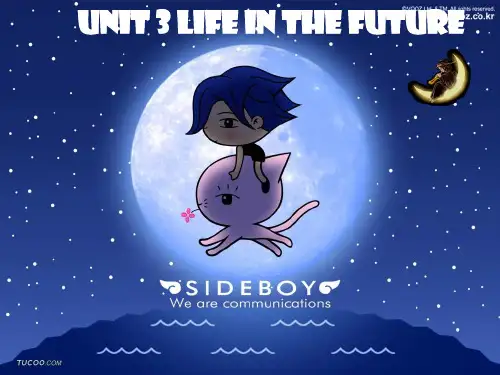
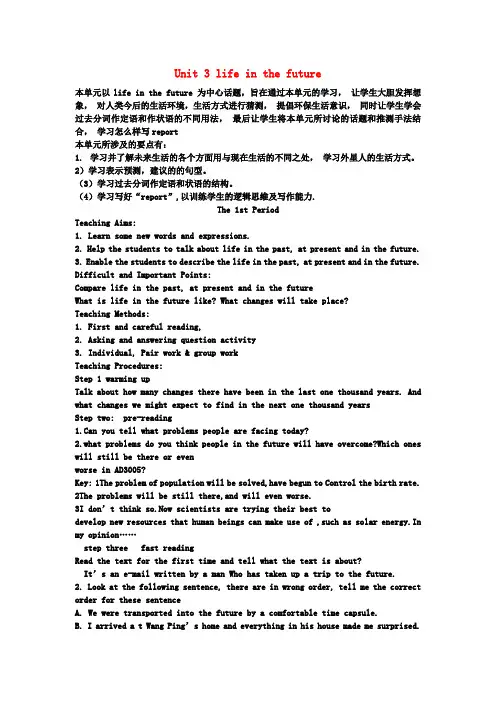
Unit 3 life in the future本单元以life in the future 为中心话题,旨在通过本单元的学习,让学生大胆发挥想象,对人类今后的生活环境,生活方式进行猜测,提倡环保生活意识,同时让学生学会过去分词作定语和作状语的不同用法,最后让学生将本单元所讨论的话题和推测手法结合,学习怎么样写report本单元所涉及的要点有:1.学习并了解未来生活的各个方面用与现在生活的不同之处,学习外星人的生活方式。
2)学习表示预测,建议的的句型。
(3)学习过去分词作定语和状语的结构。
(4)学习写好“report”,以训练学生的逻辑思维及写作能力.The 1st PeriodTeaching Aims:1. Learn some new words and expressions.2. Help the students to talk about life in the past, at present and in the future.3. Enable the students to describe the life in the past, at present and in the future. Difficult and Important Points:Compare life in the past, at present and in the futureWhat is life in the future like? What changes will take place?Teaching Methods:1. First and careful reading,2. Asking and answering question activity3. Individual, Pair work & group workTeaching Procedures:Step 1 warming upTalk about how many changes there have been in the last one thousand years. And what changes we might expect to find in the next one thousand yearsStep two: pre-reading1.Can you tell what problems people are facing today?2.what problems do you think people in the future will have overcome?Which ones will still be there or evenworse in AD3005?Key: 1The problem of population will be solved,have begun to Control the birth rate. 2The problems will be still there,and will even worse.3I don’t think so.Now scientists are trying their best todevelop new resources that human beings can make use of ,such as solar energy.In my opinion……step three fast readingRead the text for the first time and tell what the text is about?It’s an e-mail written by a man Who has taken up a trip to the future.2. Look at the following sentence, there are in wrong order, tell me the correct order for these sentenceA. We were transported into the future by a comfortable time capsule.B. I arrived a t Wang Ping’s home and everything in his house made me surprised.C.I won a travel to the year AD3005D. I have my first try to master a hovering carriage.Step four careful reading1.why did I have the chance to travel to the year AD3005?2. What is a “ time lag”?3. How did I feel when I was in the capsule?4who guides my trip?5.why did my guide give me some tables?6.who transported us to the future?Key 1. I took up the prize I won the year before.2. “Time lag”means a person gets flashbacks from his previous time period.3. The seats in the capsule are very comfortable.4. My friend Wang Ping is my guide to the future.5. The tablets could help me feel less nervous and uncertain6. Wan g Ping’s parents’ company transported us to the future.1How did I feel as soon as I was transported to the future?After the writer was transported to the future,he was hit by the lack of fresh air.2.how did Wang Ping solve this problem?Wang Ping gave a mask to the writer and hurried him through to a small room nearby to have a rest.3.what do you think has caused this kind of problem?Now we are causing more and more pollution to the nature,this will cause serious problems to life in the nature.This may be the cause of the lack of fresh air in the future.1 What did Wang Ping’s house look like?His house is a large bright ,clean room.It had a green Wall,a brown floor and soft lighting .2 What was the green wall made of? What’s the purpose of buildin g this kind of green wall?The green wall was made of trees.The leaves of the trees will provide much-needed oxygen to the house.3 How can you produce a TV set in Wang Ping’s house?You can just flash a switch on the computer screen and a TV set will rise from the floor.Sample answers Ex.2I think the writer has an optimistic view of the future.He was very excited when he traveled to the year AD 3005 an d couldn’t elie ve if was true.From this,we can see he is eager to go to the future.Though ehe was hit by the lack of fresh air,。
高中英语 Unit 3 Life in the future Reading学案新人教版必修5【学习目标】1、Get Ss talk about the future world、2、Read the text “First Impressions”3、 Identify and underline new words and expressions when reading the passage、4、 Find out the main idea of each para、【重点难点】1、The basic information is important for Ss to get a further understanding about theme parks、2、 Master the underlined words and expressions in reading passage、预习案Exploring Case (Fast-reading)Task1 Skimming Read the passage quickly and answer the following questions1)Why did Li Qiang go into thefuture?__________________________________________________ __________________________2)How did he feel when he left his owntime?____________________________________________________ ________________________3)What did he notice first when he arrived inAD3008?__________________________________________________ __________________________Task2 Scanning Choose the best answers according to the text、1)What is the main idea of the passage?A、First impression about Li Qian g’s travel to the future、B、How to travel to the future、C、What the future life will be like、D、An exciting experience、2)The author and his friends were safely transported into the future in a ________、A、time capsuleB、hovering carriageC、flying chairD、plane3)What did the author feel in the first few days?A、He was upset and comfortable、B、He felt frightened、C、He suffered a lot of pain、D、He felt uneasy and not sure4)What was the room like?A、It was large,clean with broken walls、B、The walls are colored and moveable、C、There are pipes sending oxygen the room needs、D、Tables and chairs are placed against the wall、5)From the passage we can infer that ________、A、Wang Ping often travels to the futureB、Li Qiang has been to the future twiceC、Li Qiang’s parents didn’t agree to his travelD、People in the future don’t have to eat food 探究案Exploring Case (Careful-reading)Task1 Read the passage carefully and match the main idea of each paragraph、Para、1A、Staying in Wang Ping’s home、 Para、2B、 My impressions of life one thousand years into the future、 Para、3C、 The journey Para、4D、 How I came to take a time travel journey、Task2 SummaryWe climbed into a time1、________ through a small opening、After a calming2、________,we fell asleep、 A few3、________ later we arrived on the earth one thousand years in the future、At first my4、________ ached for lack of fresh air、Wang Ping asked me to put on a5、________ and took me to a small room、 I felt better at once、We flew away in our separate hovering6、________、When arriving at a house,he showed me into a7、________,bright clean room,the8、________ of which was made of trees、Wang Ping produced a table,some chairs and a bed from the9、________、After he left,I10、________ something,took a hot bath and went to bed、Task3 词汇用法及难句分析。
Unit 3 Life in the future Ⅰ. 单元教学目标Ⅱ. 目标语言Ⅲ. 教材分析与教材重组1. 教材分析本单元以“Life in the future”为中心话题,旨在通过本单元的学习,让学生大胆发挥想象,对人类今后的生活环境,生活方式进行猜测,并在此基础上,对人类的种种活动进行反思,提倡环保生活意识。
同时让学生学会过去分词作定语和作状语的不同用法。
最后让学生将本单元所讨论的话题和推测手法相结合,学习怎样写report。
1.1 Warming Up 部分利用一个关于“住”和“行”的对比研究表格引导学生回顾过去,认识现在和展望未来。
通过这一活动,引发学生对过去,现在和未来的思考,使学生对将要阅读的文章有个知识准备。
1.2 Pre-reading 部分让学生充分运用发散思维,先列举当今世界人类面临的一些突出问题,然后要求学生思考为什么会产生这些问题,这些问题中哪些在未来社会仍然可能存在,哪些将会被克服,哪些将会恶化。
为下面的阅读做了铺垫。
1.3 Reading 部分通过一封发自未来的电子邮件,讲述了作者Li Qiang怎样安全到达“未来世界”,他对“未来世界”的印象,以及“未来世界”的日常生活方式和交通工具情况。
阅读时要把重点放在“未来世界”生活与当今生活的不同点上。
1.4 Comprehending 部分设计了三个教学活动来加深学生对Reading部分的理解。
第一个活动要求学生通过阅读找出“未来世界”在以下几个方面的变化:跨时空旅行,交通,住房,城镇环境和空气质量。
接着让学生在此基础上得出自己的结论,哪些变化好,哪些变化不好,并说明理由。
第二个活动要求学生通过阅读来判断Li Qiang对“未来世界”的态度是乐观的还是悲观的。
学生要在文中找出支持自己观点的论据,尽可能说服别人。
第三个活动让学生想象一下Li Qiang将会去参加哪些活动。
这样既鼓励学生展开丰富的想象,又为Using Language部分的语篇学习做了铺垫。
ReadingThe General Idea of This PeriodThis is the second period of this unit. This period centers on the reading passage, which is about first impressions in the future. At the beginning of the period, the teacher can design some activities to draw the s tudents’ attention to read.In order to attract the students’ attention, the teacher had better offer the students the opportunities to have a competition about preparing knowledge of future. Then the teacher can make full use of the pictures present in the text. Ask the students to predict what the passage may be mainly about. This step is designed to make for preparing for understanding the passage.Reading skills are very important for senior students. For the first reading, we intend to cultivate Ss’ sk imming ability and scanning ability. First ask the students to scan it and find out characters mentioned. Then let the students read fast to find out main idea of each paragraph. In order to stimulate Ss to take part in the class activity more actively, the teacher can organize a group competition to see which group can finish the task fastest and best. For the second reading, the students are expected to know some details about the passage. Later on, the teacher will present five statements for the students to judge and ask some questions. The third time is to read for study further information. This part is designed to get Ss into the habit of reading a passage as a whole, that is, to get the general idea. Another purpose of this part is to ask Ss to pay attention to the details.To develop Ss’ further understanding ability, the teacher can design some questions, whose answers are beyond lines. So the teacher will help them to read between the lines, thus Ss can gradually get the ability to understand the w riter’s implied meanings. In this step, the teacher can also design the exercise of guessing the meaning of new words or phrases. The teacher asks Ss to read it again in order to make them think about the organization of the whole passage, and this method can help them not only in their understanding but also in writing a passage.To consolidate the content of the passage, Ss are required to retell it according to main idea.In order to arouse the Ss interest; the teacher can hold a competition between groupTeaching Important PointsHave a good understanding of the text through the exercises.Get the students to learn different reading skills, especially gist reading and understanding beyond lines.Teaching DifficultiesKnow the meanings between lines and beyond lines.Learn different reading skills for different reading purposes.Teaching AidsMulti-media classroom and other normal teaching tools.Three Dimensional Teaching AimsKnowledge AimsHave a good understanding of the text through the exercises.Ability AimsEmotional AimsStir the students’ imagination for the future life to encourage them to workTeaching ProcedureStep 1 GreetingT: Hello, my frieFirst Talking about what to see(The teacher had better prepare some pictures or movies about great changes, which have happened, compared with the ancient time.)T: Now let us enjoy some picturS: In the past flying into the sky was only a dream, while now it has come true. Shenzhou 6 safely took off on Oct.12th and returned to the earth on Oct.17th successfully.S: What has happened today is quite diS: I think great changes have taken place, which is making our life easier and easier.S: I think people used to breathe fresh air and drink clean water while we are suffering from pollution today.Second BrainstormingT: If today were a day of 3000 years, can you imagine what your life will be like in the future? Use your heads and good imagination to describe your future life. You can refer to the questions if you like.(Showing the questions on the screen.)1. Where will you live in the future?2. How will you travel in the future?3. Where will you work and study in the future?4. What kind of money will you use?5. Will you still get sick?(Two minutes later, ask one or two of the students to something about the future life.)S: In the future people will communicate more easily and conveniently. They can talk on the phone and send e-mails on the Internet, like shopping, reading, borrowing books, depositing money, ordering meals or tickets.S: Human beings will look healthier in the future. In spite of this they still get sick. However, scientists will have a better understanding of how cancerS: In the future people will travel to different places. Not only do they enjoy local travel but also they travel abroad.Third PresentationT: I enjoy your imagination about future. Some people are looking forward tofuture. No one knows what will really happen tomorrow. Time will tell us all. Seeing is believing. Now, let’s read a new passage, in which there is a boy who has gone to the future in AD3005 in advance. He will tell us the first impressions what he has found inFourth Talking about picturesT: First, let’s enjoy some pictures on Page 18.Can you describe what the pictures say? Prepare for it in two minutes, and then exchange your idea with your partner. Finally you will show your opinion in the whole(The teacher is to join in talking with students. Later, ask some to report what the pictures are about.)T: Now, would you please predict what the passage might be mainly about according to pictures?S: I think it may tell us the trip to the future in AD 3005 depending on picture one.S: According to the second picture, the author will show us around the future.S: In the picture three, I can see some equipment in the future home, so I think it will introduce some advanced home in the future.T: Excellent. Now, let’s read to see whether what you predict is right.Step 3 ReadingFirst Scanning to find out main charactersT: Scan the passage and find out who are mentioned in the passage.What is the relationship between them?S: Li Qiang, Wang Ping, Li Mengxi (Wang Ping’s mother).Wang Ping is Li Qiang’sT: The passage is an E-mail in fact. Who wrote this e-mail? And who is the e-mail for? What is his e-mail?S: Li Qiang wrote to his parents. His e-mail is Liqiang299A@ Great Adventure Space- .Second Skimming to find out main idea for each paragraphT: Skim each paragraph and find out main idea for each one. When you want to find main idea of each paragraph, you especially pay attention to the first sentence and the last one, which may help you find the main idea quickly. I will give you(The teacher offers three minutes to the students to do it. Later ask some students to answer.)Suggested answers:Para 3 He was confused by tThird Listening to the tape to tell the following statements true or false T: Listen to the tape to catch some important information about the passage. Then you will be asked to tell the following statements on the screen true or false.(Let the students listen. The teacher should present the statements on the1. Li Qiang was very excited to go on the journey to the future.2. They arrived on the other planets one thousand in the future.3. He was confused by the new surroundings.4.5. Wang Ping’s home is similar to ours.T: Since we have finished listening to it, now let’s te ll the followingS: It is wrong. Li Qiang was very worried about the journey instead of beingT: Right. What about the next one?S: It is also wrong. In fact they arrived on the earth but one thousand yearsT: Yes. Do you agree on it?S: While flying he lost in sight of his friend.T: Quite good. What about the last one?S: It is wrong. Because he visited the home in the future in AD 3005, it is quite different from ours.T: Reasonable.Fourth Careful-reading to answer questionsT: Now, let’s read the passage carefully to learn about more details. LaterI will let you answer s1. How did he feel about the journey to the year AD 3005?2. What is time lag?3. How did his friend help him to complete the journey?4.5. What did he suffer from the new surroundings? How did Wang Ping help him?6. When and why did he get lost?7. Introduce what he found in his friend’s home in the future.Suggested answers:1.2. Time lag is similar to the “jet lag” you get when flying, but instead it3. Wang Ping was very understanding and gave him some green tablets, which helpeda lot. Later, his parents’ company named “Future Tours” transported him safely into the future in a time capsule.4. They arrived there by time capsule. They climbed in through the round opening. The seats were comfortable and after a calming drink, which made them sleepy, their eyes closed. The capsule shook, as they lay relaxed. Sounds came from below their feet as they rose slowly from the ground. A few minutes later the journey was5. He was hit by the lack of fresh air. His head ached. His friend asked him6. He got lost when they reached what looked like a large market because of the people flying by in all directions. They were so many carriages that he lost sight7. He found a large bright, clean room with a green wall, which can be moved. In fact there were trees, whose leaves provided the house with much needed oxygen.A table and chairs rose from under the floor as if by magic. Spreading some foodFifth Reading for further understandingT: “I still cannot believe that I am taking up my prize that was won last year.”What does “taking up” mean in the sentence?S: It meansT: Right. “Taking up” means “getting down to doing something or star to do something.”T: What does “hit”mean in the sentenceS: I think it meansT: Yes, “hit” here means “have a bad or sudden effect on (a person orT: The reading passage describes some good and bad changes to life in AD 3005.In pairs, discuss which changes are good or bad and give reasons for your choices. Thendiscussion at the same time. After that, the students will be asked to show theirT: Have a class discussion and decide whether you think the writer has an optimistic or a pessimistic view of the future. Take a few minutes to read through the passage again. Make notes to help you remember your reasons. Be prepared to join in a class discussion. Try to persuade others to agree with you.(There is no fixed answer either. If the students can support their idea with strongly reasonable facts, they should be praised. In order to draw many students to join in the discussion, the teacher had better design a competition between groups. If they volunteer to show their opinion, they will be given a star.If their ideaSixth ImaginationT: Now let’s imagine. What would you like to visit if you were LiS: If I were Li Qiang, I would visit some schools in the future in AD 3005.S: If I were Li Qiang, I would go on visits to some labs to find out what the people in theS: If I were Li Qiang, I would pay a visit to the History Museum to find whetherSs: ...Step 4 ConsolidationT: In this period, we have visited the future in AD 3005 with Li Qiang. What have you learned from the first impressions? Can you sum up it in several sentences?I will give you two minutes to prepare for it.S: At the beginning of the travel to the future, Li Qiang felt very nervous.With his friend, Wang Ping, helped, they arrived safely on the earth but one thousand years in the future by time capsule. On arriving, he was confused by the new surroundings. When he was hit by the lack of fresh air, his friend advised him to wear a mask, which made him feel much better soon .Later, they visited some places by hovering carriages driven by computer, which float above the ground. In the end, they arrived at his friend’s home, where almost everything was controlled bycomputer, so the life there seemed very conveniently.T: Excellent. Please write a passage about the first impressions of the future if you were Li Qiang, who were to visit the future.The Design of the Writing on the BlackboardUnit 3 Life in the futureup my prize tResearch and ActivitiesUse your imagination to write a short passage about what maybe happen in the future. Imagine if you were to visit the future in one thousand years, how would you go on the journey and what would you pay a visit to? You will describe your experiences and surroundings. You can imitate the structure of the reading passage,but you must make full use of your imagination to write what is different from First Impressions.Reference for TeachingFirst Chinese space hero safely return to earthWrapping up a historic day in space, the Shenzhou 5 return capsule parachuted to a soft touchdown today, bringing to an end China’s first manned voyage in to spaceTouchdown came at 6: 23 a.m.local time Thursday (22: 23 GMT; 6: 23 p.m.EDT Wednesday), according tothe central Chinese television network CCTV and the Xinhua news org anization. Video from the landingsite showed the craft’s single occupant —Lt.Colonel Yang Liwei —waving to a crowd assembled around the capsule as it lay on its side minutes after landing.Chinese media also reported the landing point was just 4.8 kilometers from theYang was carried away from the spacecraft in a seat and lookeda bit wobbly and dazed on state television coverage of the event. Official reports from Xinhua say Yang “was confirmed to remain in good health” after his 21-hour stint in orbit.After its launch early Wednesday from the Jiuquan space center aboard a Long March 2F rocket, the Shenzhou 5 spacecraft entered orbit with passenger Yang Liwei, a 38-year old Chinese fighter pilot that found himself thrust into the internationalThroughout his historic 21-hour journey, the 5-foot, 6-inch taikonaut —or yuhangyuan —reported no ill effects and no technical problems with the spacecraft were reported. Conversations with the ground control center in Beijing reportedly went as expected as communications was relayed through tracking stations and sea vessels scattered around the world.As expected, Shenzhou 5’s entry and service modules were jettis oned from the orbital module as the time neared for the pivotal de-orbit burn to bring the taikonaut back to Earth. Thrusters were then fired to nudge the craft out of orbit and to put it on a trajectory to land in the steppes of Inner Mongolia, about 1000 kilometers from the launch site at Jiuquan. The orbital module remained behind in space toIn all, the mission lasted approximately 21 hours, 23 minutes from liftoff to touchdown. The historic flight completed 14 orbits of Earth and traveled about 600 000 kilometers.“Yang’s return to land from outer space signifies completion of the first step taken by China to implement its plans for space exploration.More steps are to follow—attempts for space walk, rendezvous and docking of spaceships and setting“Sometime from now, up in the space, high up over the Earth, there will be adesigned, built and manned by the Chinese, ”the agency said.Wearable HalfkeyboardIt’s quite interesting to use a pocketable keyboard with a Palm or PPC to write something.I borrowed a Palmone Tungsten T and a Logitech TypeAway Keyboard from a boy yesterday. The Keyboard uses the universal port to connect the palm.It is a Palm Vx on the keyboard:The wearable Halfkeyboard was designed to let you turn your PDA into a wearable computer.Drugs delivered by robots in the bloodA 3 millimetre-long swimming robot constructed by Chinese scientists could eventually be used for drug delivery or to clear arteries in humans.The craft is propelled by an external magnetic field which controls its fins. The fins are made from an alloy that contracts in response to application of the field.The next stage is to build a robot with fins that respond to different magnetic field resonance. This would enable an operator to control the fin separately andsteer the robot around.The project is at an early stage but in the future remote controlled machines could be used to deliver drugs to a particular part of the body.The watch reminds you’ve forgotten the keysGaetano Borriello, a University of Washington computer scientist has developed a working prototype of a smart swatch system.Like pretty anything called “smart” these days, it works with RFID tags.The wristwatch acts as an interface, driven by a personal server the wearer can carry in a pocket, but which will eventually be a part of the wristwatch itself. Important items are labeled with RFID tags and RFID readers are installed at various locations to read the tags.The UW smart watch system works as follows: an RFID reader senses the tags on, say, your books, relays the data to the personal server in your pocket. The server checks if anything has been forgotten, and if so, it sends a prompt to the wristwatch to alert you.The server also takes into account the last known location of items, your calendar and where you may be going.“This is really part of a larger effort to create an RFID-enabled building, a sort of microcosm of what society would be like if these things take off, ”said Borriello who hopes to have a building-wide system up and running within a year.。
Unit 3 Life in the future 教案Warming Up, Prereading & Reading prehendingTeaching Goals:1.To illustrate Ss’ imagination of future life.2.To arouse Ss to pay more attention to the problems that probably appeared in the futurelife.3.To make Ss know the difference of life between the past, present and future.Teaching Procedures:Step 1 LeadinginPurpose: To talk about past and future changes of life.1. Group workLet Ss discuss the questions in groups of four.(1)How do you usually get to school?(2)Where do you live, in a city or in the countryside?(3)Where would you like to live in the future?(4)Do you live in a flat or a house?(5)Do you have a room of you won? Can you describe the room in the picture?(6)What kind of housing would you like to have in the future?(7)What would you like to have in your room?(8)What can we use to build houses? (brick, stone , steel , glass, ice, wood , plastic bamboo, …)2. ConclusionThis unit introduces what life in the future might be like to Ss. By discussing and answering the questions above can make Ss have a general understanding of the present and future life and can also illustrate Ss’ imagination about the future life.Step 2. Warming Up1. Pair workIn pairs let Ss list the changes in housing, transport, jobs, families and education will happen in the next century.2. Individual workAccording to the result of the above Pair work, fill in the chart.表格 1Suggested Answers:表格2Present time In One Thousand Years’ TimeTransport Airplanes cars bicycles No longer by air because of environmental pollutionbicycles and horses will make a ebackWork Office factoryconstruction landscapeserviceAt home using advanced, interactive putersmeetings can be conducted on the puter and peoplewill see each other speak.Finance andcurrencyBanks offices insurancebusinessOne global currency—maybe the yuan as China willbe the largest global exporterLanguage English RussianChineseOne global language perhaps Chinese or stillEnglishEnvironment Air: could be improvedin citiesVery poor need to recycle all waste control on theuse of cars no airplanes methods to improve poorair quality. Climate of the earth being very hot ismaking problems over water resourcesEducation Nursery schoolsuniversityLonger than now possibly until 25 years of age sothat students can learn all the new technologies Houses Flats houses concretewoodBuilt into the ground as the surface of the earth isso hot.munication Post office Internet By thoughtpad, telephone, puter, mobiles, Morsecode, etcStep 3. Prereading1. Pair workAsk Ss to discuss the following questions in pairs.(1)Make a list of the problems human beings are facing today.(2) What problems do you think people will have overe in one thousand years? Which ones do you think will still exist in AD 3008?Suggested Answers:(1) The seven serious problems facing mankind:① The first problem I would like to point out is the decline of morality.(道德沦丧)② The second problem is the racial bias problem. (种族歧视)③ The third problem , which is a most serious problem , is the rapid depletion of resources on the Earth. (资源匮乏)④ Now I e to the fourth problem, the problem of the large gap between the poor and the rich . (贫富悬殊)⑤ The fifth problem is the pollution problem.(环境恶化)⑥ Now I would like to talk about the sixth problem, the expensive arms race problem. (军备竞争)。
⑦ The seventh problem is that the technologies vital to the welfare of human beings are being more and more concentrated in the hands of a small group of people. (技术垄断)(2) Various answers are acceptable.2. DiscussionShow Ss the above pictures and ask them what problems each picture shows. This can arouse Ss interest. Ask Ss to have a wide range of discussion about the present and future life. They can discuss as much as they can.Suggested Answers:Picture one: global warming,Picture two: acid rain,Picture three: growing areas of desert,Picture four: over large world population,Picture five: lack of enough drinking water,Step 4. Reading1. Skimming(1)Pair work:Ask Ss to look the three pictures (P18) and then discuss with their partners and answer the following questions:① Picture one:* What can you see in the picture?* What are the people doing?* Where do you think they are doing?② Picture two:* How many people can you see in the picture?* Who are they, do you know?* What else can you see in the picture?* What can you use them for?③ Picture 3.* What can you see in the picture?* Where is Li Qiang?* What is Li Qiang doing?* What is the table and chairs made of?* What is the wall made of? What function does it have?(2) Discussion:Ask Ss read through the text as quickly as possible and talk about Li Qiang’s first impressions of AD 3008, and at the same time underline words, phrases, or sentences that are close ly related to Li Qiang’s first impressions.2. Scanning(1) Team workAsk Ss to discuss how far their ideas of the future are from those in the story. Let themdiscuss the following questions.① Do you think Li Qiang is impressed by what he finds in the future? Why or why not?② What improvements do you think there will be to your home city or home village onethousand years in the future? What problems might there be?③ What ideas do you think were believable in this story? Why?④ Which ideas do you think are too unrealistic? Why?(2) Group workThis text is written as if it were a letter from a son to his parents. He is telling them his impressions in an informal way. So the descriptions are mixed with his impressions to give you his idea of what the future is like. Now please discuss the style of the text.①Do you think Li Qiang’s descriptions are fair? Why or why not?② What language does he use that gives you that impression?③ Do you think he feels fortable in the future? Why or why not?④ What language does he use that gives you that impression?3. prehendingAsk Ss to tell the following sentences are True or False (T or F)(1) Li Qiang was worried about the journey, so he was unsettled all the time.(2) Wang Ping is his friend who is also a good guide.(3) His head ached because of lack of oxygen.(4) Li Qiang lost in touch with Wang Ping, but he found him at last.(5) Wang Ping’s mother was not friendly to him.Suggested Answers: (1) F (2) T (3) F (4) T (5) F4. ListeningStep 6. Homework1.Read the text again and again and go over the main language points.2.Finish Ex1 and Ex2 in Learning about language.3.Retelling the story, either in writing or in speech, is very useful to learners of a foreignlanguage. It demonstrates his understanding of the story. Next you are going to practise in pairs retelling Li Qiang’s story traveling to the year AD 3008. You may make use of the words and expressions you have just learnt.。